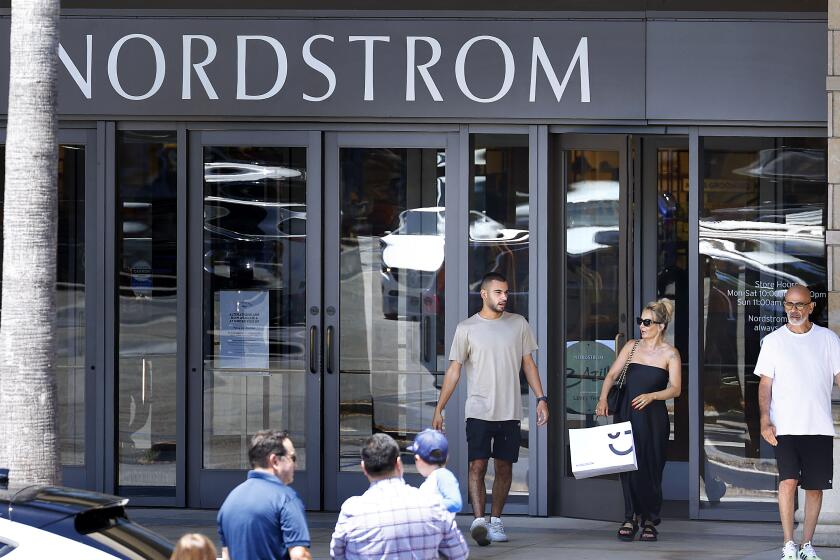Dow Advances Past 9,000; S&P; Crosses Key Threshold
- Share via
Another afternoon rally drove stocks broadly higher Thursday, pushing the Dow Jones industrial average to its first close above 9,000 in seven weeks.
The advance left the Standard & Poor’s 500 index up more than 20% from its five-year low reached on July 23. By some yardsticks, crossing that threshold marks the start of a new bull market--though many analysts say it is far too early to make that claim.
In other trading, the dollar surged against the yen and the euro, suggesting that foreign investors may be returning to U.S. stocks. Treasury bond yields continued to rebound.
On Wall Street, the Dow industrials rose 96.41 points, or 1.1%, to 9,053.64, the first finish above 9,000 since July 9.
The S&P; 500 index gained 13.34 points, or 1.4%, to 962.70, and the Nasdaq composite was up 13.70 points, or 1%, to 1,422.95.
Stocks meandered for much of the session before buyers took control in the final 90 minutes. Winners topped losers by about 2 to 1 on the New York Stock Exchange and by 10 to 7 on Nasdaq.
Blue chips leading the market higher included drug firms Johnson & Johnson, up $1.31 to $56.20, and Eli Lilly, up $4.03 to $62.15; General Motors, up $1.31 to $49.32; and American Express, up $1.16 to $38.19.
At Thursday’s close, the S&P; 500 is up 20.7% since it bottomed at 797.70 on July 23. The Dow is up 17.5% since then and Nasdaq is up 15.8%.
Some analysts judge a 20% rise from an index’s low to constitute the beginning of a new bull move.
“It’s our thought that this is probably the start of the recovery and not just a bear-market rally,” said Chris Orndorff, head of equities at Payden & Rygel, a Los Angeles money management firm.
“The bottom line is that stock prices respond to earnings,” Orndorff said, “and we think earnings have bottomed out and are finally starting to recover.”
Profit for the S&P; 500 companies overall rose in the second quarter, the first year-over-year gain since the fourth quarter of 2000, according to earnings-tracker Thomson First Call.
Even so, Orndorff warned, “markets rarely move in a straight line,” so a “re-test” of the July 23 lows is possible, he said.
Some analysts are emphatic that the rebound since late July is nothing more than a temporary respite within an ongoing bear market.
John McGinley, editor of Technical Trends newsletter in Wilton, Conn., said he is suspicious “in spades” about the rally. He said the advance has occurred amid weak trading volume compared with the activity in June and July, when share prices were sinking amid heavy volume.
In judging the importance of market phases, “There’s only one kind of volume to rely on, and that’s increased volume,” McGinley said. He expects key indexes to fall below their July 23 levels, if not in the next four months then in 2003.
“I think the smart money stays on the sidelines for now,” he said.
One big brokerage, CS First Boston, told clients Thursday to trim stock holdings in light of the recent rally. The firm advised fund managers to cut equities to 62% of total assets, down from 65%, and boost cash holdings to 7% from 4%, while keeping bonds at 31%.
One closely watched measure of investor sentiment turned more downbeat this week: Investors Intelligence’s weekly poll of investment newsletter editors showed that 40% are bearish on the market outlook, up from 37.4% the previous week. The bullish percentage fell to 36.7% from 38.5%, while those who are expecting a modest market pullback, at worst, eased to 23.3% from 24.1%.
But “contrarian” analysts say the higher level of caution could be bullish in the near term because the market often does its best to confound the majority viewpoint.
Another potentially positive sign for stocks is the dollar’s strength. It closed at 119.89 yen on Thursday, up from 118.45 on Wednesday, while the euro fell to 97 cents from 97.9 cents. A rising dollar can mean that foreign money is pushing into U.S. assets.
Some analysts said foreigners may be hunting for U.S. corporate bonds, as issuance of new bonds continues to resurge this week.
Hunger for those securities also may be luring money from lower-yielding Treasury securities. The yield on the benchmark 10-year T-note rose to 4.32% on Thursday, up from 4.20% on Wednesday and the highest in a week.
*
(BEGIN TEXT OF INFOBOX)
Rally Rulers
The blue-chip S&P; 500 has led the rebound since the market hit five-year lows July 23.
Change since: Index 7/23 12/31
S&P; 500 +20.7% -16.2%
NYSE comp. +19.8 -12.6
Wilshire 5,000 +19.4 -15.2
S&P; mid-cap +17.6 -8.5
Dow 30 +17.5 -9.7
Nasdaq 100 +17.0 -33.5
Nasdaq comp. +15.8 -27.0
S&P; small-cap +15.4 -9.7
Source: Bloomberg News
More to Read
Inside the business of entertainment
The Wide Shot brings you news, analysis and insights on everything from streaming wars to production — and what it all means for the future.
You may occasionally receive promotional content from the Los Angeles Times.










